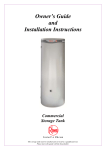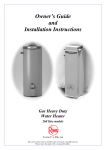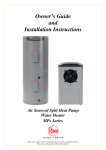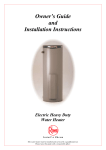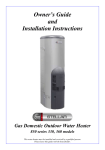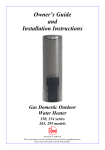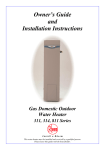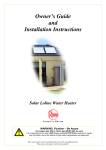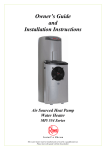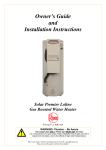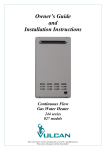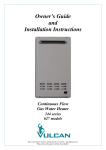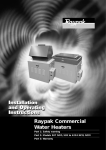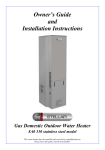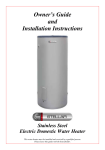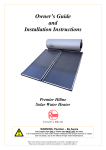Download Rheem 265 litre Technical data
Transcript
Owner’s Guide and Installation Instructions Gas Heavy Duty Water Heater 265 litre and 275 litre models This water heater must be installed and serviced by a qualified person. Please leave this guide with the householder. Warning: Upon completion of the installation and commissioning of the water heater, leave this guide with the householder or responsible officer. DO NOT leave this guide inside of the cover of the water heater, as it may interfere with the safe operation of the water heater or ignite when the water heater is turned on. PATENTS This water heater may be protected by one or more patents or registered designs in the name of Rheem Australia Pty Ltd. ® TRADEMARKS Registered trademark of Rheem Australia Pty Ltd. TM Trademark of Rheem Australia Pty Ltd Note: Every care has been taken to ensure accuracy in preparation of this publication. No liability can be accepted for any consequences, which may arise as a result of its application. CONTENTS RESPONSIBLE OFFICER – We recommend you read pages 4 to 16. The other pages are intended for the installer but may be of interest. About Your Water Heater ............................................................................................................ 4 Regular Care ................................................................................................................................ 8 Water Supplies........................................................................................................................... 11 Save A Service Call ................................................................................................................... 14 Installation .................................................................................................................................. 17 Connections – Plumbing .......................................................................................................... 26 Connections – Electrical ........................................................................................................... 29 Multiple Installations ................................................................................................................. 33 Commissioning .......................................................................................................................... 37 Lighting The Water Heater ........................................................................................................ 38 Draining The Water Heater ....................................................................................................... 40 Temperature Control ................................................................................................................. 41 Warranty ..................................................................................................................................... 43 3 ABOUT YOUR WATER HEATER WATER HEATER APPLICATION This water heater is designed for the purpose of heating potable water. Its use in an application other than this may shorten its life. MODEL TYPE ® The Rheem Heavy Duty Gas water heater model you have chosen is either a 265 litre or 275 litre indoor or outdoor quick recovery water heater. Water is stored in a vitreous enamel lined steel cylinder and heated by a gas burner located under the cylinder. The heat produced by the burner is transferred to the water through the base of the cylinder and through the wall of a flue pipe which passes through the centre of the cylinder. A flue baffle in this flue ensures the efficiency of the water heater is correct. The gas supply to the burner is controlled by the thermostat so the water is heated to a constant temperature. Automatic safety controls are fitted to the water heater to provide safe and efficient operation. MAINS PRESSURE The water heater is designed to operate at mains pressure by connecting directly to the mains water supply. If the mains supply pressure in your area exceeds that shown on page 19, a pressure limiting valve must be fitted. The supply pressure should be greater than 350 kPa for true mains pressure operation to be achieved. HOW HOT SHOULD THE WATER BE? The water heater has a maximum temperature setting of 82°C and a minimum temperature setting of 60°C. Refer to “Temperature Adjustment” on page 5. For applications requiring sanitising temperatures, the thermostat should be set at 82°C. Note: For temperatures above 80°C, a circulator must be installed. maximum thermostat setting (82°C) To meet the requirements of the National Plumbing Standard the temperature of the stored water must not be below 60°C. minimum recommended stored water temperature and minimum thermostat setting If this water heater is installed as an in-series booster water heater as part of a commercial solar water heating system, to maximise solar contribution it is recommended the thermostat is set at 60°C, unless sanitising temperatures are required. maximum recommended supply temperature to bathrooms, ensuites and public areas Note: AS 3498 requires that a water heater provides the means to inhibit the growth of Legionella bacteria in potable water. This water heater can satisfy this AS 3498 requirement provided it is operating and the thermostat setting is 60°C or higher, including when it is used as an in-series booster water heater for a solar water heater. HOTTER WATER INCREASES THE RISK OF SCALD INJURY This water heater can deliver water at temperatures which can cause scalding. Check the water temperature before use, such as when entering a shower or filling a bath or basin, to ensure it is suitable for the application and will not cause scald injury. We recommend and it may also be required by regulations that an approved temperature limiting device be fitted into the hot water pipe work to the bathing and public areas when this water heater is installed. This will keep the water temperature below the maximum permitted by AS/NZS 3500.4 to these areas. The risk of scald injury will be reduced and still allow hotter water to the kitchen, laundry and other areas requiring sanitising temperatures. 4 ABOUT YOUR WATER HEATER TEMPERATURE ADJUSTMENT The water heater features an electronic adjustable thermostat. We recommend only a licensed tradesperson make any temperature adjustments. We advise the thermostat be adjusted to the lowest temperature setting that meets your needs, especially if there are young children or elderly people in the premises. Refer to “Hotter Water Increases the Risk of Scald Injury” on page 4. ELECTRONIC THERMOSTAT The thermostat automatically operates the gas control by switching its power on and off, so a constant temperature is maintained. The thermostat is mounted externally on the water heater and the protective over temperature cut out is mounted inside the lower front cover of the water heater. There is no need to switch the water heater off when it is not in use. The thermostat is fully automatic and only allows the gas control to open when the burner requires gas for heating. The thermostat displays the current water temperature. To adjust the thermostat settings refer to “Temperature Control” on page 41. HOT SURFACE IGNITION The water heater incorporates an automatic burner ignition system. A hot surface igniter (HSI) probe automatically heats up when the thermostat registers heating of the water is required. When the HSI probe is fully energised, the gas valve opens allowing gas to the burner which in turn is ignited by the HSI probe. WARNING This water heater is only intended to be operated by persons who have the experience or the knowledge and the capabilities to do so. This water heater is not intended to be operated by persons with reduced physical, sensory or mental capabilities i.e. the infirm, or by children. Children should be supervised to ensure they do not interfere with the water heater. This water heater uses 240 V AC electrical power for operation of the control systems and the electrically operated components. The removal of the access cover(s) will expose 240 V wiring. They must only be removed by a qualified person. The water heater is fitted with a power supply cord and plug and must be plugged into a weatherproof electrical outlet if installed outdoors. Take care not to touch the power plug with wet hands. SAFETY If the power supply cord or electrical conduit to the water heater is damaged, it must be replaced by a qualified person in order to avoid a hazard. The power supply cord and plug must be replaced with a genuine replacement part available from Rheem. Phone Rheem Service or their nearest Accredited Service Agent to arrange for an inspection. This water heater is supplied with a thermostat, an over-temperature cut-out, and a combination temperature pressure relief valve. These devices must not be tampered with or removed. The water heater must not be operated unless each of these devices is fitted and is in working order. The operation of the over-temperature cut-out on the thermostat indicates a possibly dangerous situation. If the over-temperature cut-out operates, it must not be reset and the water heater must be serviced by a qualified person. Warning: For continued safety of this water heater it must be installed, operated and maintained in accordance with the Owner‟s Guide and Installation Instructions. The Rheem warranty may not cover faults if relief valves or other safety devices are tampered with or if the installation is not in accordance with these instructions. 5 ABOUT YOUR WATER HEATER Do not store flammable or combustible materials near the water heater. Flammable liquids (such as petrol), newspapers and similar articles must be kept well away from the water heater and the draught diverter or flue terminal. Gases from some aerosol sprays, stain removers and household chemicals become corrosive when drawn into a flame. Do not use aerosols and stain removers near the water heater whilst it is working. Do not store swimming pool chemicals, household cleaners, etc., near the water heater. Do not place anything on top of the water heater or in contact with the draught diverter or flue terminal. Ensure the flue terminal is not obstructed in any way at any time. Do not use Propane / Butane gas mixtures in a Propane model. A Propane model is designed to operate on Propane only. The use of Propane / Butane mixture, such as automotive LPG fuel, in a Propane model is unsafe and can cause damage to the water heater. PRECAUTIONS Where damage to property can occur in the event of the water heater leaking, the water heater must be installed in a safe tray. Construction, installation and draining of a safe tray must comply with AS/NZS 3500.4 and all local codes and regulatory authority requirements. The water heater must be maintained in accordance with the Owner‟s Guide and Installation Instructions. Refer to “Regular Care” on page 8 and to “Anode Inspection and Replacement” on page 12. If this water heater is to be used where an uninterrupted hot water supply is necessary for your application or business you should ensure that you have back up redundancy within the hot water system design. This should ensure the continuity of hot water supply in the event that this water heater were to become inoperable for any reason. We recommend you seek advice from your plumber or specifier about your needs and building back up redundancy into your hot water supply system. TO TURN OFF THE WATER HEATER If it is necessary to turn off the water heater: Switch off the electrical supply at the isolating switch to the water heater(s). Close the gas isolation valve(s) at the inlet to the gas control(s). Close the cold water isolation valve on the cold water line to the water heater(s) to shut down the entire system, or; Close the isolation valves on the cold and hot water branches to shut down an individual water heater in a bank. TO TURN ON THE WATER HEATER Open the isolation valves fully on the cold and hot water branches to the water heater(s) installed in a bank. Open the cold water isolation valve on the cold water line to the water heater(s). Air will be forced out of the taps. Open the gas isolation valve(s) fully at the inlets to the gas control(s). Switch on the electrical supply at the isolating switch to the water heater(s). 6 ABOUT YOUR WATER HEATER HOW DO I KNOW THE WATER HEATER IS INSTALLED CORRECTLY? Installation requirements are shown on pages 17 to 24. The water heater must be installed: by a qualified person, and in accordance the installation instructions, and in compliance with Standards AS/NZS 3500.4, AS 5601 or AS/NZS 5601.1, as applicable under local regulations, and all local codes and regulatory authority requirements. In New Zealand the installation must also conform with the New Zealand Building Code. VICTORIAN CUSTOMERS Notice to Victorian Customers from the Victorian Plumbing Industry Commission. This water heater must be installed by a licensed person as required by the Victorian Building Act 1993. Only a licensed person will give you a Compliance Certificate, showing that the work complies with all the relevant Standards. Only a licensed person will have insurance protecting their workmanship for 6 years. Make sure you use a licensed person to install this water heater and ask for your Compliance Certificate. DOES THE WATER CHEMISTRY AFFECT THE WATER HEATER? The water heater is suitable for most public water supplies, however some water chemistries may have detrimental effects on the water heater, its components and fittings. Refer to “Water Supplies” on page 11. If you are in a known harsh water area or you are not sure of your water chemistry, have your water checked against the conditions described on pages 11 to 13. HOW LONG WILL THE WATER HEATER LAST? The water heater is supported by a manufacturer‟s warranty (refer to page 43). There are a number of factors that will affect the length of service the water heater will provide. These include but are not limited to the water chemistry, the water pressure, the water temperature (inlet and outlet) and the water usage pattern. Refer to “Precautions” on page 6. 7 REGULAR CARE MINOR SIX MONTH MAINTENANCE It is recommended minor maintenance be performed every six months by a responsible officer. The minor maintenance includes: Operate the easing lever on the temperature pressure relief valve. It is very important you raise and lower the lever gently. Refer to “Temperature Pressure Relief Valve” on page 10. Warning: Exercise care to avoid any splashing of water, as water discharged from the drain line will be hot. Stand clear of the drain line‟s point of discharge when operating the valve‟s lever. Operate the easing lever on the expansion control valve (if fitted). It is very important you raise and lower the lever gently. Refer to “Expansion Control Valve” on page 9. Check the drain line from the safe tray (if one is installed) is not blocked. ANNUAL SERVICE For safe and efficient operation, it is recommended an annual service be conducted on the water heater. Warning: Servicing of a water heater must only be carried out by qualified personnel. Phone Rheem Service or their nearest Accredited Service Agent. Note: The annual service and routine replacement of any components, if required, are not included in the Rheem warranty. A charge will be made for this work. Only genuine replacement parts should be used on this water heater. The annual service includes the following actions: Inspect and flush the temperature pressure relief valve. Inspect and flush the expansion control valve (if fitted). Check and if necessary adjust the inlet gas pressure. Check the operation of and clean the main burner. Visually check the unit for any potential problems. Inspect all connections. Check the drain line from the safe tray (if one is installed) is not blocked. Note: The water heater may need to be drained during this service. After the completion of the service, the water heater will take some time to reheat the water. Hot water may not be available for a while. 8 REGULAR CARE MAJOR FIVE YEAR SERVICE It is recommended a major five year service be conducted on the water heater. Warning: Servicing of a water heater must only be carried out by qualified personnel. Phone Rheem Service or their nearest Accredited Service Agent. Note: The five year service and routine replacement of any components, such as the anode and relief valve(s), are not included in the Rheem warranty. A charge will be made for this work. Only genuine replacement parts should be used on this water heater. The major service includes the following actions: Replace the temperature pressure relief valve. Inspect and flush the expansion control valve (if fitted). If required, replace the valve. Inspect and if required, replace the anodes. If the anodes are not replaced, they should be replaced within three years of this service (refer to “Anode Inspection and Replacement” on page 12). Check and if necessary adjust the inlet gas pressure. Check the operation of and clean the main burner. Drain and flush the water heater if required. In commercial applications where large volumes of hot water are used, sediment may build up on the bottom of the cylinder and reduce the heating efficiency. In extreme cases, particularly in areas of high water sediment, draining and flushing out may be necessary. Visually check the unit for any potential problems. Inspect all connections. Check the drain line from the safe tray (if one is installed) is not blocked. Note: The water heater may need to be drained during this service. After the completion of the service, the water heater will take some time to reheat the water. Hot water may not be available for a while. EXPANSION CONTROL VALVE In many areas, including South Australia, Western Australia and scaling water areas, an expansion control valve is fitted to the cold water line to the water heater. The expansion control valve may discharge a small quantity of water from its drain line during the heating period instead of the temperature pressure relief valve on the water heater. Operate the easing lever on the expansion control valve once every six months. It is very important you raise and lower the lever gently. The expansion control valve should be checked for performance or replaced at intervals not exceeding 5 years, or more frequently in areas where there is a high incidence of water deposits. 9 REGULAR CARE TEMPERATURE PRESSURE RELIEF VALVE This valve is near the top of the water heater and is essential for its safe operation. It is possible for the valve to release a little water through the drain line during each heating period. This occurs as the water is heated and expands by approximately 1/50 of its volume. Continuous leakage of water from the valve and its drain line may indicate a problem with the water heater (refer to “Temperature Pressure Relief Valve Running” on page 15). Warning: Never block the outlet of this valve or its drain line for any reason. Operate the easing lever on the temperature pressure relief valve once every six months. It is very important you raise and lower the lever gently. Warning: Failure to do this may result in the water heater cylinder failing. Warning: Exercise care to avoid any splashing of water, as water discharged from the drain line will be hot. Stand clear of the drain line‟s point of discharge when operating the valve‟s lever. water heater If water does not flow freely from the drain line when the lever is lifted, then the water heater must be checked. Phone Rheem Service or their nearest Accredited Service Agent to arrange for an inspection. The temperature pressure relief valve should be replaced at intervals not exceeding 5 years, or more frequently in areas where there is a high incidence of water deposits (refer to “Water Supplies” on page 11). 10 lift until water flows from the drain line – lower gently drain line WATER SUPPLIES This water heater must be installed in accordance with this advice to be covered by the Rheem warranty. This water heater is manufactured to suit the water conditions of most public reticulated water supplies. However, there are some known water chemistries which can have detrimental effects on the water heater and its operation and / or life expectancy. If you are unsure of your water chemistry, you may be able to obtain information from your local water supply authority. This water heater should only be connected to a water supply which complies with these guidelines for the Rheem warranty to apply. CHANGE OF WATER SUPPLY The changing or alternating from one water supply to another can have a detrimental effect on the operation and / or life expectation of a water heater cylinder and a temperature pressure relief valve. Where there is a changeover from one water supply to another, e.g. a rainwater tank supply, bore water supply, desalinated water supply, public reticulated water supply or water brought in from another supply, then water chemistry information should be sought from the supplier or it should be tested to ensure the water supply meets the requirements given in these guidelines for the Rheem warranty to apply. ANODE The vitreous enamel lined cylinder of the water heater is only covered by the Rheem warranty when the total dissolved solids (TDS) content in the water is less than 2500 mg/L and when the correct colour coded anode is used. If an incorrect colour coded anode is used in the water heater, any resultant faults will not be covered by the Rheem warranty. In addition, the use of an incorrect colour coded anode may shorten the life of the water heater cylinder. The correct colour coded anode must be selected and fitted to the water heater in accordance with the following advice and the Anode Selection chart on page 11 for the Rheem warranty to apply to the water heater cylinder. Total Dissolved Solids Anode colour code 0 – 40 mg/L Green 40 – 150 mg/L Green or Black 150 – 400 mg/L Black 400 – 600 mg/L Black or Blue 600 – 2500 mg/L Blue 2500 mg/L + Blue (no cylinder warranty) The changing of anodes must be carried out by a qualified person. Note: Some water analysis reports may state the conductivity of the water rather than the level of total dissolved solids. Conductivity, measured in microsiemens per centimetre (µS / cm), is directly proportional to the TDS content of the water. TDS, in mg / L, is approximately 70% of the conductivity in µS / cm. TOTAL DISSOLVED SOLIDS & CONDUCTIVITY (vitreous enamel lined water heater cylinder) no warranty applies warranty applies to a vitreous enamel lined water heater cylinder if the correct coloured anode is used for the TDS / conductivity level of water 0 40 Green 0 60 150 400 600 TOTAL DISSOLVED SOLIDS (TDS) - mg/L Black 215 570 2500 Blue 860 CONDUCTIVITY - µS/cm ANODE SELECTION 11 to a vitreous enamel lined water heater cylinder Blue 3570 WATER SUPPLIES ANODE INSPECTION AND REPLACEMENT The anodes installed in your water heater will slowly dissipate whilst protecting the cylinder. The life of the cylinder may be extended by replacing the anodes. If the anodes are not replaced during a five year service (refer to “Major Five Year Service” on page 9) then the maximum time after installation when the anodes should be replaced for this water heater is 8 years. For water supplies which are either softened, desalinated or where the water supply may alternate between a water tank and a reticulated public supply or another supply, it is recommended the anodes be replaced within 5 years of installation. CAUTION If the water supply has a TDS greater than 150 mg/L and a green anode has not been changed to a black anode, or if the TDS is greater than 600 mg/L and the anode has not been changed to a blue anode, there is the possibility the anode may become overactive and hydrogen gas could accumulate in the top of the water heater during long periods of no use. In areas where this is likely to occur, the installer should instruct the householder on how to dissipate the gas safely. If, under these conditions, the water heater has not been used for two or more weeks the following procedure should be carried out before using any electrical appliances (automatic washing machines and dishwashers) which are connected to the hot water supply. The hydrogen, which is highly flammable, should be vented safely by opening a hot tap and allowing the water to flow. There should be no smoking or naked flame near the tap whilst it is turned on. Any hydrogen gas will be dissipated. This is indicated by an unusual spurting of the water from the tap. Once the water runs freely, any hydrogen in the system will have been released. SATURATION INDEX The saturation index (SI) is used as a measure of the water‟s corrosive or scaling properties. In a corrosive water supply, the water can attack copper parts and cause them to fail. In a scaling water supply calcium carbonate is deposited out of the water onto any hot metallic surface. Where the saturation index exceeds +0.40, the water is very scaling. An expansion control valve must be fitted on the cold water line after the non-return valve to protect and for the Rheem warranty to apply to the temperature pressure relief valve and water heater cylinder. Water which is scaling may be treated with a water softening device to reduce the saturation index of the water. Refer to the Saturation Index chart on page 13. Refer to the cold water connection detail on page 26 for the position of the expansion control valve. 12 WATER SUPPLIES no warranty applies to a: temperature pressure relief valve or a water heater cylinder unless an expansion control valve is fitted. SATURATION INDEX (SI) GAS STORAGE WATER HEATERS WITHIN WARRANTY SPECIFICATION -1.0 very corrosive 0 +0.4 SATURATION INDEX (calculated @ 80°C water temperature) scaling corrosive +0.8 very scaling SUMMARY OF WATER CHEMISTRY ADVICE AFFECTING WARRANTY The water heater and its components are not suitable for certain water chemistries. Those chemistries are listed below. If the water heater is connected at any time to a water supply with the following water chemistry, the Rheem warranty will not cover any resultant faults on the components listed below: Water Chemistry Component Total Dissolved Solids (TDS) > 2500 mg/L water heater cylinder Total Dissolved Solids (TDS) not suitable for anode type water heater cylinder Saturation Index (SI) > +0.4 (if expansion control valve is not fitted) water heater cylinder temperature pressure relief valve 13 SAVE A SERVICE CALL Check the items below before making a service call. You will be charged for attending to any condition or fault that is not related to manufacture or failure of a part. NOT ENOUGH HOT WATER (OR NO HOT WATER) Is the electricity switched on? Inspect the isolating switch adjacent to the water heater and ensure it is turned on. Is there a time clock on the power supply? Check the settings on the time clock and ensure they are suitable to enable heating when it is required. Is the ignition system ‘locked out’? Reset the water heater. Refer to “Water Heater Not Operating” on page 14. Is a code displayed on the electronic thermostat? Check the LED display on the electronic thermostat. If a code is displayed, refer to “Diagnostic Features of Electronic Thermostat” on page 15. Are you using more hot water than you think? Are outlets (especially the showers) using more hot water than you think? Very often it is not realised the amount of hot water used, particularly when showering. Carefully review the hot water usage. Have your plumber fit a flow control valve to each shower outlet to reduce water usage. Temperature pressure relief valve running Is the relief valve discharging too much water? Refer to “Temperature Pressure Relief Valve Running” on page 15. Thermostat setting Ensure the thermostat setting is appropriate. You may choose to have your electrician adjust the thermostats upwards to gain additional hot water capacity. Warning: Hotter water increases the risk of scald injury. Water heater size Do you have the correct size water heater for your requirements? The sizing guide in the Rheem sales literature and on the Rheem website (www.rheem.com.au) suggests average sizes that may be needed. WATER HEATER NOT OPERATING The ignition system may have „locked out‟. To reset the water heater, switch the electrical supply off at the isolating switch, wait ten seconds then switch on again. If the water heater fails to light, phone Rheem Service or their nearest Accredited Service Agent to arrange for an inspection. 14 SAVE A SERVICE CALL DIAGNOSTIC FEATURES OF ELECTRONIC THERMOSTAT This water heater incorporates an electronic thermostat. In the event of a fault occurring with the thermostat, a 2-digit code will be displayed. Code E1 Fault Temperature sensor failure If the fault code is displayed, phone Rheem Service or their nearest Accredited Service Agent to arrange for an inspection. BURNER WILL NOT LIGHT Is the fan in the air duct (631 275 model only) operating continuously? Ensure the front cover is securely in position. Switch off the electrical supply at the isolating switch, wait 30 seconds and then switch the electrical supply on again. Phone Rheem Service or their nearest Accredited Service Agent to arrange for an inspection if the water heater burner fails to light. Is there gas to the water heater? Check the gas isolation valve on the gas supply line is open. Is there a normal gas supply to the rest of the premises? Try lighting another gas appliance. If there is no gas call your gas provider. Is the ignition system ‘locked out’? Try resetting the water heater. Refer to “Water Heater Not Operating” on page 14. TEMPERATURE PRESSURE RELIEF VALVE RUNNING Normal Operation It is normal and desirable that this valve allows a small quantity of water to escape during the heating cycle. However, if the discharge is deemed excessive (more than 2% of hot water used), there may be another problem. Continuous dribble Try gently raising the easing lever on the relief valve for a few seconds (refer to “Temperature Pressure Relief Valve” on page 10). This may dislodge a small particle of foreign matter and clear the fault. Release the lever gently. Steady flows for long period (often at night) This may indicate the mains water pressure sometimes rises above the designed pressure of the water heater. Ask your installing plumber to fit a pressure limiting valve. Warning: Never replace the relief valve with one of a higher pressure rating. Heavy flows of hot water until water heater is cold - then stops until water reheats The water heater must be switched off at the switchboard. Phone Rheem Service or their nearest Accredited Service Agent to arrange for an inspection. EXPANSION CONTROL VALVE RUNNING If an expansion control valve is fitted in the cold water line to the water heater (refer to page 26) it may discharge a small quantity of water instead of the temperature pressure relief valve on the water heater. The benefit is that energy is conserved as the discharged water is cooler. 15 SAVE A SERVICE CALL WATER HEATER APPEARS TO BE LEAKING When the water heater is first lit or after a large usage of hot water, condensation may form on the burner of the water heater. This is quite normal, especially in winter months and will dry off as the water is heated. HIGHER THAN EXPECTED GAS BILLS Should you at any time, feel your gas account is higher than expected, we suggest you check the following points: Is the relief valve running excessively? Refer to “Temperature Pressure Relief Valve Running” on page 15. Are outlets (especially the showers) using more hot water than you think? Refer to “Not Enough Hot Water” on page 14. Is there a leaking hot water pipe, dripping hot water tap, etc? Even a small leak will waste a surprising quantity of hot water and gas. Replace faulty tap washers, and have your plumber rectify any leaking pipe work. Has there been an increase in hot water usage? An increase in hot water usage will result in an increase in water heater operation. Has your water heating tariff rate been increased by your gas retailer since your previous account? IF YOU HAVE CHECKED ALL THE FOREGOING AND STILL BELIEVE YOU NEED ASSISTANCE, PHONE RHEEM SERVICE OR THEIR NEAREST ACCREDITED SERVICE AGENT. 16 INSTALLATION THIS WATER HEATER IS NOT SUITABLE FOR POOL HEATING. Check the water heater is suitable for the gas type available. (refer to the rating label on the water heater) Note: In Australia, natural gas models can be connected to SNG, however the hourly gas consumption may be reduced (typically by 10%). INSTALLATION STANDARDS The water heater must be installed: by a qualified person, and in accordance the installation instructions, and in compliance with Standards AS/NZS 3500.4, AS 5601 or AS/NZS 5601.1, as applicable under local regulations, and all local codes and regulatory authority requirements. In New Zealand the installation must also conform with the New Zealand Building Code. All packaging materials must be removed from the water heater prior to its installation. This includes the removal of the cardboard base of the carton from the underside of the water heater and the protective packaging from the draught diverter of an indoor model. WATER HEATER APPLICATION This water heater is designed for the purpose of heating potable water. Its use in an application other than this may shorten its life. If this water heater is to be used where an uninterrupted hot water supply is necessary for the application or business, then there should be redundancy within the hot water system design. This should ensure the continuity of hot water supply in the event that this water heater was to become inoperable for any reason. We recommend you provide advice to the system owner about their needs and building backup redundancy into the hot water supply system. Note: AS 3498 requires that a water heater provides the means to inhibit the growth of Legionella bacteria in potable water. This water heater can satisfy this AS 3498 requirement provided it is operating and the thermostat setting is 60°C or higher, including when it is used as an in-series booster water heater for a solar water heater. WATER HEATER LOCATION An indoor model must be installed indoors and an outdoor model must be installed outdoors, except where a 631 275 model water heater is installed indoors with a room sealed installation kit. The water heater should be installed either close to the most frequently used outlets or with a circulated flow and return system and its position chosen with safety and service in mind. Make sure people (particularly children) will not touch the flue outlet. The flue terminal must be clear of obstructions and shrubbery. Clearance must be allowed for servicing of the water heater. The water heater must be accessible without the use of a ladder or scaffold. Make sure the temperature pressure relief valve lever is accessible and the front covers or panels, thermostats and burner can be removed for service. You must be able to read the information on the rating plate. If possible leave headroom of one water heater height so the anode can be inspected or replaced. Remember you may have to take the entire water heater out later for servicing. 17 INSTALLATION The water heater must not be installed in an area with a corrosive atmosphere where chemicals are stored or where aerosol propellants are released. Remember the air may be safe to breathe, but when it goes through a flame, chemical changes take place which may attack the water heater. For a single water heater installation, follow the diagrams on pages 23 and 24. For multiple water heater installations, follow the instructions on pages 33 to 36. INDOOR INSTALLATION The water heater is to be installed at floor level and must stand vertically upright on a stable fireproof base as acceptable to local authorities. There are also special requirements in AS 5601 and AS/NZS 5601.1 for water heaters installed in a garage, an enclosed space and other locations. Remember all local authorities have regulations about putting water heaters into roof spaces. For indoor models the distances set out in the diagram should be observed. Keep the water heater and flue at least 25 mm clear of walls, cupboards, timber or any other combustibles and at least 500 mm clear of curtains and furnishings. Ventilation The ventilation of a room or an enclosure such as a cupboard, where the water heater is installed must comply with AS 5601 or AS/NZS 5601.1. If the water heater is installed in a room or an enclosure, where the total thermal input of the water heater and any other gas burning appliance(s) exceeds 3 MJ / h for each cubic metre of room or enclosure volume, an adequate air supply must be provided. For efficient water heater operation allow two permanent openings into the room or enclosure, each of at least: 2 66,000 mm for each 110 MJ model 2 120,000 mm for each 200 MJ model Clearance Requirements Duty Gas Indoor Water Heaters The distance between the top of the upper opening and the ceiling and the distanceHeavy between the bottom of the lower opening and the floor must not exceed 5% of the total height of the room or enclosure. Secondary Flue A secondary flue must be installed with an indoor water heater to discharge combustion products outside the building. The flue design and installation must comply with AS 5601 or AS/NZS 5601.1. The water heater is supplied with a draught diverter, screwed to the top of the water heater. An adaptor is also supplied with a 621 275 model. The draught diverter is designed to receive a 125 mm diameter flue (621 265 models) and a 200 mm diameter flue (621 275 models). The flue installed with a 621 275 model sits inside of the adaptor. Remove the adaptor (621 275 models) from the packaging at the top of the water heater and insert into the outlet spigot of the draught diverter cone. The secondary flue must: be seated inside of the outlet spigot (621 265 models) or the adaptor (621 275 models) of the draught diverter. be self supporting and not impose a load on the water heater. use a slip joint or similar to allow for disconnection. be designed to run vertically for the maximum possible distance, and not less than 600 mm, before any change of direction. There are particular fluing requirements for a 631 275 model water heater installed with a room sealed installation kit. Refer to the installation instructions supplied with the kit. 18 INSTALLATION OUTDOOR INSTALLATION The water heater is to be installed at ground or floor level on a stable fireproof base as acceptable to local authorities. The water heater must also stand vertically upright with the back of the water heater against or within 25 mm of an external wall or alternatively against a fireproof screen extending at least 500 mm above, below and either side the flue terminal. Failure to observe this precaution can cause problems in high wind areas. A secondary flue is not required. The water heater must be located to ensure that the location of the flue terminal complies with the requirements of AS 5601 or AS/NZS 5601.1, as applicable under local regulations. As a guide the following requirements are extracted from the Gas Installations Standard. The distances are measured along the wall behind the water heater. At least 500 mm between the top of the flue terminal and the eaves. At least 500 mm (265) or 1500 mm (275) between the flue terminal and the edge of any opening into the building, such as an openable door or window, measured horizontally*. At least 1000 mm (265) or 1500 mm (275) between the flue terminal and the edge of any opening into the building, such as an openable window, measured vertically. At least 500 mm between the flue terminal and a return wall or external corner, measured horizontally*. At least 500 mm clear of any combustibles. Note: * If these horizontal distances cannot be achieved, AS/NZS 5601.1 states an equivalent horizontal distance measured diagonally from the nearest discharge point of the flue terminal to the opening may be deemed to comply. Check with the local regulator. SAFE TRAY Where damage to property can occur in the event of the water heater leaking, the water heater must be installed in a safe tray. Construction, installation and draining of a safe tray must comply with AS/NZS 3500.4 and all local codes and regulatory authority requirements. AS/NZS 3500.4 also has particular requirements when a safe tray must be installed. MAINS WATER SUPPLY Where the mains water supply pressure exceeds that shown in the table below, an approved pressure limiting valve is required and should be fitted as shown in the installation diagram (refer to installation diagram on page 26). Model 265, 275 Relief valve setting 1000kPa Expansion control valve setting* 850kPa Max. mains supply pressure With expansion control valve 680kPa Without expansion control valve 800kPa * Expansion control valve not supplied with water heater TANK WATER SUPPLY If the water heater is supplied with water from a tank supply and a pressure pump system is not installed, then the bottom of the supply tank must be at least 1 m above the highest point of the hot water plumbing system, including the water heater. Care must be taken to avoid air locks. The cold water line to the water heater should be adequately sized and fitted with a full flow gate valve or ball valve. 19 INSTALLATION HOT WATER DELIVERY This water heater can deliver water at temperatures which can cause scalding. It is necessary and we recommend that a temperature limiting device be fitted between the water heater and the hot water outlets in any ablution and public areas such as bathrooms, ensuites or public amenities, to reduce the risk of scalding. The installing plumber may have a legal obligation to ensure the installation of this water heater meets the delivery water temperature requirements of AS/NZS 3500.4 so that scalding water temperatures are not delivered to a bathroom, ensuite, or other ablution or public area. Where a temperature limiting device is installed adjacent to the water heater, the cold water line to the temperature limiting device can be branched off the cold water line either before or after the isolation valve, pressure limiting valve and non return valve to the water heater. If an expansion control valve is required, it must always be installed after the non return valve and be the last valve prior to the water heater. If a pressure limiting valve is installed on the cold water line to the water heater and the cold water line to a temperature limiting device branches off before this valve or from another cold water line in the premises, then a pressure limiting valve of an equal pressure setting may be required prior to the temperature limiting device. Two Temperature Zones Using a Temperature Limiting Device LEGEND 20 INSTALLATION CIRCULATED HOT WATER FLOW AND RETURN SYSTEM If a Rheem water heater is to be installed as part of a circulated hot water flow and return system, a storage water heater able to provide a hot water outlet temperature of at least 60°C must be used. Note: The thermostat must always be set to at least 60°C. Refer to the diagram on page 21. Refer also to “Recirculation System” on page 41. Temperature Limiting Device A temperature limiting device cannot be installed in circulated hot water flow and return pipe work unless it is specifically designed to do so, such as the Rheem Guardian warm water system. The tempered water from a temperature limiting device cannot be circulated. Where a circulated hot water flow and return system is required in a building, a temperature limiting device can only be installed on a dead leg, branching off the circulated hot water flow and return pipe. If circulated tempered water were to be returned back to the water heater, depending on the location of the return line connection on the water supply line to the water heater, then either: water will be supplied to the cold water inlet of the temperature limiting device at a temperature exceeding the maximum recommended water supply temperature, or when the hot taps are closed no water will be supplied to the cold water inlet of the temperature limiting device whilst hot water will continue to be supplied to the hot water inlet of the temperature limiting device. These conditions may result in either water at a temperature exceeding the requirements of AS/NZS 3500.4 being delivered to the hot water outlets in the ablution areas, or the device closing completely and not delivering water at all, or the device failing. Under either condition, the operation and performance of the device cannot be guaranteed. Circulated Hot Water Flow and Return System – Gas Water Heater LEGEND 21 INSTALLATION REDUCING HEAT LOSSES The cold water line to and the hot water line from the water heater must be insulated in accordance with the requirements of AS/NZS 3500.4. The insulation must be weatherproof and UV resistant if exposed. Keep temperature settings down. Lower temperatures reduce heat losses and prolong cylinder life. Do not set the controlling electronic thermostat above 70°C unless it is necessary. A time clock to control the electrical supply can be used to switch off the water heater during hours or days when it is not in use. ANODE The vitreous enamel lined cylinder of the water heater is only covered by the Rheem warranty when the total dissolved solids (TDS) content in the water is less than 2500 mg/L and when the correct colour coded anode is used. If an incorrect colour coded anode is used in the water heater, any resultant faults will not be covered by the Rheem warranty. In addition, the use of an incorrect colour coded anode may shorten the life of the water heater cylinder. The correct colour coded anode for the water supply being used must be selected and fitted to the water heater for the Rheem warranty to apply to the water heater cylinder (refer to “Water Supplies” on page 11 and the Anode Selection chart on page 11). The black anode is typically fitted as standard. Total Dissolved Solids Anode colour code 0 – 40 mg/L Green 40 – 150 mg/L Green or Black 150 – 400 mg/L Black 400 – 600 mg/L Black or Blue 600 – 2500 mg/L Blue 2500 mg/L + Blue (no cylinder warranty) If the water supply has a TDS greater than 150 mg/L and a green anode has not been changed to a black anode, or if the TDS is greater than 600 mg/L and the anode has not been changed to a blue anode, there is the possibility the anode may become overactive and hydrogen gas could accumulate in the top of the water heater during long periods of no use. In areas where this is likely to occur, the installer should instruct the householder on how to dissipate the gas safely (refer to “Caution” on page 12). SADDLING PIPE WORK To prevent damage to the cylinder when attaching pipe clips or saddles to the water heater jacket, we recommend the use of self drilling screws with a maximum length of 13 mm. Should pre drilling be required, extreme caution must be observed when penetrating the jacket of the water heater. Note: If the cylinder is damaged as a result of attaching pipe clips or saddles to the jacket, any resultant faults will not be covered by the Rheem warranty. 22 INSTALLATION TYPICAL INSTALLATION – OUTDOOR LOCATION 631 275 model shown 23 INSTALLATION TYPICAL INSTALLATION – INDOOR LOCATION 621 275 model shown 24 INSTALLATION DIMENSIONS AND TECHNICAL DATA Model No. Storage capacity (litres) Nominal Dimensions (mm) A B C D E F G H K L M P Weight empty (kg) Gas Details 621265 (Indoor) 265 1795 610 750 750 700 380 1655 36° 660 302 125 137 Hourly Gas Consumption (MJ) 631265 (Outdoor) 265 1835 610 710 750 700 380 1655 36° 660 302 420 146 621275 (Indoor) 275 1895 640 780 760 700 340 1695 36° 722 320 200 172 Min. Gas Pressure (kPa) 631275 (Outdoor) 275 1865 640 780 760 700 340 1695 36° 722 320 320 187 Test Point Gas Pressure (kPa) 265 275 265 275 265 275 110 / 100 200 / 180 1.13 1.13 0.85 0.9 95 190 0.75 0.75 0.32 0.5 TLP 90 190 0.75 0.75 0.32 0.5 Propane 100 190 2.75 2.75 2.5 2.65 Butane 95 160 2.75 2.75 2.5 2.65 Universal LPG 84 150 2.75 2.75 2.5 2.65 Natural / SNG (typical) Town Model numbers: N = Natural; T = Town; P = Propane; B = Butane, L = Universal LPG. Letter N, T, P, B or L is included in the model number, e.g. 621275N0, to denote gas type. Note: Universal LPG models are available in New Zealand only. Technical data is subject to change. 25 CONNECTIONS – PLUMBING All plumbing work must be carried out by a qualified person and in compliance with the Standard AS/NZS 3500.4 and all local codes and regulatory authority requirements. All gas work must be carried out by a qualified person and in compliance with the Standard AS 5601 or AS/NZS 5601.1, as applicable under local regulations, and all local codes and regulatory authority requirements. CONNECTION SIZES Hot water connection: Rp 1¼. Cold water connection: Rp 1¼. Relief valve connection: Rp 3/4. Gas inlet: Rp 3/4. WATER INLET AND OUTLET All pipe work must be cleared of foreign matter before connection and purged before attempting to operate the water heater. All olive compression fittings must use brass or copper olives. Use thread sealing tape or approved thread sealant on all fittings. An isolation valve and non-return valve must be installed on the cold water line to the water heater. An acceptable arrangement is shown in the diagram or on page 35 for multiple installations. Refer also to “Hot Water Delivery” on page 20 and to “Mains Water Supply” on page 19. A disconnection union must always be provided at the cold water inlet and hot water outlet on the water heater to allow for disconnection of the water heater. This water heater has either a plastic dip tube or fitting liner in the inlet and outlet fittings (see diagram). These must be in place for the water heater to function properly. Do not remove or damage them by using heat nearby. They will be pushed into the correct position as the fitting is screwed in. PIPE SIZES The cold water pipe to the water heater should be the same size or bigger than the hot water line from the water heater. The pipe sizing for hot water supply systems should be carried out by persons competent to do so, choosing the most suitable pipe size for each individual application. Reference to the technical specifications of the water heater and local regulatory authority requirements must be made. 26 CONNECTIONS – PLUMBING TEMPERATURE PRESSURE RELIEF VALVE The temperature pressure relief valve is shipped in the plastic bag attached to the side of the water heater. The temperature pressure relief valve must be fitted before the water heater is operated. Before fitting the relief valve, make sure the probe has not been bent. Seal the thread with Teflon tape - never hemp. Make sure the tape does not hang over the end of the thread. Screw the valve into the correct opening (refer to the installation diagram on pages 23 and 24) leaving the valve drain pointing downwards. Do not use a wrench on the valve body - use the spanner flats provided. A copper drain line must be fitted to the temperature pressure relief valve (refer to "Relief Valve Drain" on page 27). The valve must be insulated with closed cell polymer insulation or similar (minimum thickness 9 mm) and the insulation installed so as not to impede the operation of the valve. The insulation must be weatherproof and UV resistant if exposed. EXPANSION CONTROL VALVE Local regulations may make it mandatory to install an expansion control valve (ECV) in the cold water line to the water heater. In other areas, an ECV is required if the saturation index is greater than +0.4 (refer to “Water Supplies” on page 11). The expansion control valve must always be installed after the non return valve and be the last valve installed prior to the water heater (refer to diagram on page 26). A copper drain line must be fitted to the expansion control valve (refer to "Relief Valve Drain" on page 27). The valve must be insulated with closed cell polymer insulation or similar (minimum thickness 9 mm) and the insulation installed so as not to impede the operation of the valve. The insulation must be weatherproof and UV resistant if exposed. RELIEF VALVE DRAIN DN20 copper drain lines must be fitted to the temperature pressure relief valve and expansion control valve (if one is installed) to carry the discharge clear of the water heater. Connect the drain lines to the valves using disconnection unions. The drain line from the valve to the point of discharge should be as short as possible, have a continuous fall all the way from the water heater to the discharge outlet and have no tap, valves or other restrictions in the pipe work. A drain line from a relief valve must comply with the requirements of AS/NZS 3500.4. A drain line must be no longer than 9 metres with no more than three bends greater than 45° before discharging at an outlet or air break. The maximum length of 9 metres for a drain line is reduced by 1 metre for each additional bend required of greater than 45°, up to a maximum of three additional bends. Where the distance to the point of final discharge exceeds this length, the drain line can discharge into a tundish. Subject to local regulatory authority approval, the drain lines from the temperature pressure relief valve and expansion control valve from an individual water heater may be interconnected. The outlet of a drain line must be in such a position that flow out of the pipe can be easily seen, but arranged so discharge will not cause injury, damage or nuisance. The termination point of a drain line must comply with the requirements of AS/NZS 3500.4. Drain lines must not discharge into a safe tray. In locations where water pipes are prone to freezing, drain lines must be insulated, must not exceed 300 mm in length and are to discharge into a tundish through an air gap of between 75 mm and 150 mm. If a drain line discharges into a tundish, the drain line from the tundish must be not less than DN25. The drain line from a tundish must meet the same requirements as for a drain line from a relief valve. For multiple installations the drain line from each water heater can discharge into a common tundish (refer to “Multiple Installations” on pages 33 and 34). Warning: As the function of the temperature pressure relief valve on this water heater is to discharge high temperature water under certain conditions, it is strongly recommended the pipe work downstream of the relief valve be capable of carrying water exceeding 93°C. Failure to observe this precaution may result in damage to pipe work and property. 27 CONNECTIONS – PLUMBING GAS INLET The gas connection is made to the left hand side of the gas control. The pipe work must be cleared of foreign matter before connection and purged before attempting to light the water heater. An isolation valve and disconnection union must be used to allow servicing and removal of the water heater. Note: Refer to the Gas Installations Standard AS 5601 or AS/NZS 5601.1 for the correct method of sizing the gas supply pipe to the water heater. The pipe size selection must take into account the gas input of this water heater (refer to table on page 25) as well as all of the other gas appliances in the premises. Warning: Always isolate the water heater before pressure testing the gas supply system. Disconnect the water heater after the isolating cock to prevent the risk of serious damage to the gas control. The Rheem warranty does not cover damage of any nature resulting from failure to observe this precaution. Refer to rating label for gas types and pressures. Ensure the gas line is also purged at the union of the gas control. If this procedure is not followed, a retry lockout (i.e. single flashes on control module) may result on initial start up. The HSI system has a flame sensing period of 2.5 seconds from the time the gas valve opens. If the burner flame is not sensed during this period, a five minute waiting period follows so any unburnt gas can escape before a second and third burner ignition is automatically attempted. If the third attempt is also unsuccessful, the system enters the re-ignition attempt lockout mode. The LED on the control module has a series of flashes to indicate this mode (refer to label on the access cover). The electrical supply to the water heater must be turned off and then on again, or the reset button on the control module must be pressed to allow further ignition attempts. Caution: Care is necessary when tightening fittings into the gas valve. The gas valve casting may crack if the fittings are over tightened. Cracked valve castings are not covered under the Rheem warranty. Damaged valves must be replaced. 28 CONNECTIONS – ELECTRICAL The power supply to the water heater must not be switched on until the water heater is filled with water and a satisfactory megger reading is obtained. Note: AS 3498 requires that a water heater provides the means to inhibit the growth of Legionella bacteria in potable water. This water heater can satisfy this AS 3498 requirement provided it is operating and the thermostat setting is 60°C or higher, including when it is used as an in-series booster water heater for a solar water heater. ELECTRICAL CONNECTION All electrical work and permanent wiring must be carried out by a qualified person and in accordance with the Wiring Rules AS/NZS 3000 and all local codes and regulatory authority requirements. The water heater, supplied with a 1.8 metre power cord, requires a 240 V general power outlet (GPO) to be located within 1.2 metres of the installation. The GPO is required to be weatherproof for an outdoor installation. Should it be necessary to provide permanent wiring, the water heater must be directly connected to a 240V AC 50 Hz mains power supply with a double pole isolating switch installed adjacent to and accessible from the water heater. A 20 mm flexible conduit is required for the electrical cable to the water heater. The conduit is to be connected to the unit with a 20 mm terminator. Ensure there are no excess wire loops inside the front cover. The power consumption of the water heater is: Model Power consumption 621, 631 265 150 Watts gas control operation 621 275 150 Watts gas control operation and includes flue damper 631 275 250 Watts gas control operation and includes fan Comments The water heater will only operate on a sine wave at 50 Hz. Devices generating a square wave cannot be used to supply power to the water heater. The water heater can be wired for use with a remote control thermostat or a remote time switch. The water heater thermostat should be adjusted to a temperature higher than the setting on a remote thermostat. Method of Wiring for Remote Control or Time Switch 29 CONNECTIONS – ELECTRICAL THERMOSTAT SETTING The thermostat is adjustable from 60°C to 82°C. For reasons of safety and economy, we advise the thermostat is set at the lowest temperature that will provide sufficient hot water. Discuss the thermostat setting requirements with a responsible officer. Refer to “Temperature Control” on page 41. If this water heater is installed as an in-series booster water heater as part of a commercial solar water heating system, to maximise solar contribution it is recommended the thermostat is set at 60°C, unless sanitising temperatures are required. WIRING A POWER FLUED SYSTEM TO THE WATER HEATER An indoor model can be wired to a power flued system. A power flued system must be designed by a qualified person to suit the particular installation and for approval by the gas supply authority. The power flue system must be interlocked with the water heater(s) to prevent the water heater(s) from operating if the power flue is not working. The principle of operation for multiple gas water heater control with a power flue is the same as for a single water heater. Any water heater can switch on the fan and the burners can only come on when the sail switch is closed. To connect a power flue into the water heater system design, it is necessary to remove the bridging wire from the terminal block of the water heater and connect the wiring to the power flue to these two terminals. Refer to the wiring diagrams for the connection points on the water heater. 621 265 621 275 Wiring Diagrams 30 CONNECTIONS – ELECTRICAL POWER FLUE EXTERNAL CONTROLS – INTERMITTENT OPERATION Notes 1. Power source for the water heater, fan and control circuit must be from the same circuit. 2. R1 monitors return signal. 3. R2 monitors alarm signal. 4. T1 to be set for 20-30 seconds. 5. Meets requirements of Clause H2.2.6 of AS5601 or Clause H2.2.5 of AS/NZS 5601.1, as applicable under local regulations, providing lockout in the event of flue product flow failure. 6. Where intermittent fan operation is utilised, it is necessary to run the fan for some time after combustion ceases to prevent flue spillage of combustion products. T2 to be set for 5 minutes. jumper lead must be removed for connection to a power flue 2 For a single water heater installation, connect 1 and 2 directly to the water heater 1 1 INTERLOCK TERMINAL 621 SERIES RHEEM 2 1 2 1 INTERLOCK TERMINAL RAYPAK B TYPE WIRING DIAGRAM - POWER FLUE CONNECTION multiple water heater installation INTERMITTENT FAN OPERATION-MULTIPLE WATER HEATER Rheem Heavy Duty Gas Water Heaters-621 Series 31 Raypak B Type Water Heaters-B0507 to B4224 2 CONNECTIONS – ELECTRICAL POWER FLUE EXTERNAL CONTROLS – 24 HOUR OPERATION Notes: WIRING DIAGRAM - 24 HR FAN OPERATION POWER FLUE CONNECTION 1. Power source forand the SINGLE water heater, fan and control circuit be fromTYPE the same circuit. (197- 427) MULTIPLE RHEEM 621 SERIES &must RAYPAK A SERIES WATER HEATERS 2. R1 monitors return signal. 3. R2 monitors alarm signal. 4. T1 to be set for 20-30 seconds. 5. Use SPO with round earth terminal. Water heater supply cord must be changed to suit. 6. Meets requirements of Clause H2.2.6 of AS5601 or Clause H2.2.5 of AS/NZS 5601.1, as applicable under local regulations, providing lockout in the event of flue product flow failure. 32 MULTIPLE INSTALLATIONS A multiple installation of Rheem water heaters on a single manifold or multiple manifolds is possible, using ® the Rheem Equa-Flow manifold system, where large volumes of hot water are required. The Equa-Flow principle will function with water heaters in line, around a corner or in rows back to back (refer to the diagrams on page 34). The cold water and hot water manifolds must be designed to balance the flow from each water heater. To achieve this, there are basic installation requirements and principles which must be followed: 1. The maximum number of water heaters in a bank should be 8, however several banks of water heaters can be installed. 2. The hot water line from the manifold must leave from the opposite end to which the cold water line enters the manifold. 3. The water heaters must be of the same model. 4. The cold water line, cold and hot headers and hot water line must be sized to meet the requirements of both AS/NZS 3500.4 and the application. 5. A non return valve, isolation valve and if required a pressure limiting valve and expansion control valve, must be installed on the cold water line to the system. 6. A full flow gate valve or ball valve (not a stop tap, as used on a single water heater installation) must be installed on both the cold water branch and hot water branch of each water heater. 7. Non return valves or pressure limiting valves must not be installed on the branch lines to the water heaters. 8. All fittings, valves and branch lines must be matched sets all the way along the manifold. 9. Sufficient space must be left to enable access, servicing or removal of any water heater. Outdoor 631 265 models must be spaced at minimum 920 mm centres to provide the required clearance between flue terminals. 10. The temperature pressure relief valve drain line from each water heater can terminate at a common tundish (funnel) with a visible air break at each drain discharge point (refer to the diagram on page 34 and to “Relief Drain Line” on page 27). Refer to the diagrams on pages 34 to 36 for installation and plant layout details. 33 MULTIPLE INSTALLATIONS In Line Manifold Single Bank of Water Heaters Multiple Banks of Water Heaters Angle Manifold Back to Back Manifold TPR Valve Drain Line Common Discharge Point 34 MULTIPLE INSTALLATIONS TYPICAL INSTALLATION – RHEEM HEAVY DUTY GAS WATER HEATERS LEGEND RHEEM COMMERCIAL WATER HEATERS TYPICAL INSTALLATION INSTALLATION DIMENSIONS – RHEEM HEAVY DUTY GAS WATER HEATERS In Line Manifold Angle Manifold Back to Back Manifold Installation Layout Minimum Dimensions INSTALLATION LAYOUT MINIMUM DIMENSIONS MODEL Notes A B C D E* F* Model A B C D E* F* 621 265 860 610 300 100 1750 900 621 275 890 640 300 100 1780 900 2. A minimum of 900 mm (E* & F*) should be 631 265 920 610 410 410 1710 900 left in front of the water heater for access, servicing and water heater removal. 631 275 890 640 350 350 1780 900 1. Minimum recommended space between wall and back of water heater is 100 mm. 35 MULTIPLE INSTALLATIONS MANIFOLD ARRANGEMENT Hot Manifold Assembly Cold Manifold Assembly 36 COMMISSIONING TO FILL AND TURN ON THE WATER HEATER The power supply to the water heater must not be switched on until the water heater is filled with water and a satisfactory megger reading is obtained. Open all of the hot water tap(s) in the building (don‟t forget the showers) and supply cock(s) and valve(s) in the system. Open the isolation valves fully on the cold and hot water branches to the water heater(s) installed in a bank. Open the cold water isolation valve on the cold water line to the water heater(s). Air will be forced out of the taps. Close each tap as water flows freely from it. Check the pipe work for leaks. Open the gas isolation valve fully. Check the gas pipe work for leaks. Switch on the electrical supply at the isolating switch to the water heater(s). Check the pipe work again for leaks when the system has reached its working temperature. Warning: Upon completion of the installation and commissioning of the water heater, leave this guide with the householder or a responsible officer. DO NOT leave this guide inside of the cover of the water heater, as it may interfere with the safe operation of the water heater or ignite when the water heater is turned on. Explain to the householder or a responsible officer the functions and operation of the water heater. GAS INLET PRESSURE IMPORTANT – CHECK the gas supply pressure at the inlet to the water heater with the water heater and all other gas burning appliances in the premises operating (burners alight). The minimum gas supply pressures are: Natural Gas Town / TLP 1.13 kPa 0.75 kPa Propane Butane 2.75 kPa 2.75 kPa If this minimum cannot be achieved, it may indicate the meter or the gas line to the water heater is undersized. It is important to ensure that an adequate gas supply pressure is available to the water heater when other gas burning appliances, on the same gas supply, are operating. TO TURN OFF THE WATER HEATER If it is necessary to turn off the water heater on completion of the installation, such as on a building site or where the premises is vacant, then: Switch off the electrical supply at the isolating switch to the water heater(s). Close the gas isolation valve(s) at the inlet to the gas control(s). Close the cold water isolation valve on the cold water line to the water heater(s) to shut down the entire system, or; Close the isolation valves on the cold and hot water branches to shut down an individual water heater in a bank. 37 LIGHTING THE WATER HEATER FOR YOUR SAFETY READ BEFORE LIGHTING Warning: This gas water heater is designed to operate reliably and safely as long as the lighting procedure is followed exactly. Make sure the water heater is filled with water and the water supply is on, otherwise serious damage to the vitreous enamel cylinder lining and plastic components may occur. The installer must purge the gas line up to the gas control (refer to “Gas Inlet” on page 28), check all gas connections for leaks, gas supply pressure, test point pressure (refer rating label) and adjust burner aeration if necessary (refer to “Air Adjustment” on page 40). Note: 621 275 indoor model - remove the transport clip from the flue damper housing. transport clip 631 275 outdoor model - the front cover must be in place before the burner will operate. If the front cover is off when power is switched on, the system will enter re-ignition attempt lockout (refer to “Diagnostic Features Of Hot Surface Ignition Control” on page 39). A viewing window is provided to check burner operation on the water heater. LIGHTING PROCEDURE The water heater incorporates an automatic ignition system. 1. Switch on the electrical supply at the isolating switch to the water heater. 2. When the controlling thermostat registers heating is required, the hot surface igniter rod warms up for 20 seconds. The burner will automatically ignite. 3. If burner ignition is unsuccessful, a second and third re-ignition attempt will occur after a five (5) minute delay between each try. This delay is to allow for any build up of unburnt gas to escape. 4. If the third re-ignition attempt is unsuccessful, the system will enter lockout. To reset the water heater, switch the electrical supply off at the isolating switch, wait ten seconds then switch on again. If the water heater fails to light, phone Rheem Service or their nearest Accredited Service Agent to arrange for an inspection. (Qualified person only: refer to “Diagnostic Features of Hot Surface Ignition Control” on page 39). 38 LIGHTING THE WATER HEATER DIAGNOSTIC FEATURES OF HOT SURFACE IGNITION CONTROL Warning: The removal of the access covers will expose 240 V wiring. They must only be removed by a qualified person only. The water heater incorporates an electronic control module. This is located inside the access cover of an indoor model and to the right of the access cover inside the air duct on an outdoor model (refer to installation diagrams on pages 23 and 24). An LED light on the module will flash once when power is switched on to the water heater. In the event of a fault occurring in or affecting the Hot Surface Ignition system, the system will enter “lock out” and the LED will emit a series of flashes diagnosing the fault. There will be a 2 second interval between each group of flashes. Flashes reset button Fault 1 Re-ignition attempt lockout. 2 631 275 models only – Pressure switch not open. 3 631 275 models only – Pressure switch not closed. 4 Faulty igniter/igniter sensing circuit. 5 Flame sensed with gas valve de-energized. 6 Active and neutral wiring reversed. 7 Check flame sensor and/or appliance grounding. Rapid Frequency check failure. Remains on Press the reset button.* LED indicator light * Note: If the LED light remains on after pressing the reset button, the electronic control must be replaced. Phone Rheem Service or their nearest Accredited Service Agent. TEST THE WATER HEATER AFTER INSTALLATION The operation of the water heater must be thoroughly checked by the installer. The burner flame must light smoothly and quickly from the hot surface igniter and must go out quietly and completely. The burner flame must be stable, although slight lifting at the front edge of the burner is acceptable when the burner is cold. The burner flame should be blue, with a clearly defined inner cone - luminous yellow or “floating” flames are not acceptable and must be corrected by opening the interrupter screw (refer to “Air Adjustment” on page 40). Check the test point pressure and compare with the rating label. Adjust if necessary. If unable to get the water heater working properly, contact Rheem Service or their nearest Accredited Service Agent to arrange for an inspection. When satisfied everything is working properly instruct the user in the correct method of operation. Removal of the front cover on the 631 275 model whilst burner is operating will lead to re-ignition lockout (refer to “Diagnostic Features of Hot Surface Ignition Control” on page 39). 39 LIGHTING THE WATER HEATER BURNER PRESSURE ADJUSTMENT Switch off the electrical supply at the isolating switch. Attach a manometer to the test spigot at side of gas control. Switch on the electrical supply at the isolating switch. Check the gas pressure (refer to data plate). If necessary adjust the regulator under the cap on top of the gas control. AIR ADJUSTMENT The normal setting is to have the interrupter screw clear of the burner throat for Natural and LP gases. For some Town and TLP gases, the screw may need to be closed slightly to prevent flame lift-off or burning back inside burner tube. DRAINING THE WATER HEATER Warning: Exercise care, as water discharged from the water heater may be of a very high temperature. To drain the water heater: Turn off the water heater (refer to “To Turn Off The Water Heater” on page 37). Close all hot water taps. Operate the relief valve release lever - do not let the lever snap back or you will damage the valve seat. Operating the lever will release the pressure in the water heater. Attach a hose to the water heater drain cock. Let the other end of the hose go to a drain. Open the drain cock. Operate the relief valve again. This will let air into the water heater and allow the water to drain through the hose. 40 TEMPERATURE CONTROL HOTTER WATER INCREASES THE RISK OF SCALD INJURY. This water heater can deliver water at temperatures which can cause scalding. It is necessary and we recommend that a temperature limiting device be fitted between the water heater and the hot water outlets in any ablution and public areas such as bathrooms, ensuites or public amenities, to reduce the risk of scalding. The installing plumber may have a legal obligation to ensure the installation of this water heater meets the delivery water temperature requirements of AS/NZS 3500.4 so that scalding water temperatures are not delivered to a bathroom, ensuite, or other ablution or public area. RECIRCULATION SYSTEM Where the installation involves close temperature control for any purpose, or the installation is providing water above 80°C, it is essential to install a circulating pump. All valves and associated equipment must be suitable for safe operation up to the maximum thermal discharge temperature of the temperature pressure relief valve, i.e. 99°C. Where water is required at a sanitising temperature of 82°C for dishwashing or air conditioning applications, the following installation is strongly recommended: 1. A recirculation pump must be fitted. 2. The pump must be capable of withstanding working pressures greater than 1000 kPa and be constructed of materials corrosion resistant to hot water. 3. The pump should be installed with a full flow service valve on each side of it. 4. A non-return valve should be fitted in the recirculation line to prevent back flow of hot or cold water. 5. Length of branch lines off the main recirculation line should be kept to a minimum. 6. The installation of gas, electric and water services must comply with all relevant local Authorities‟ regulations. 7. The cold water supply pressure or the setting of the pressure limiting valve must not exceed the working pressure of the pump. 41 TEMPERATURE CONTROL THERMOSTAT ADJUSTMENT The water heater is supplied with the thermostat preset at 70°C. It will be necessary to adjust the thermostat temperature setting if another temperature is required. When adjusting the thermostat temperature it is necessary to alter the thermostat offset. The table outlines the thermostat temperature and the corresponding offset. Failure to adjust the offset will result in incorrect water temperature. Temperature Setting Offset 60 14 65 15 70 16 75 17 80 18 82 * 18 * Recirculation required for 82°C setting To adjust the thermostat temperature setting and offset: 1. Press the “set” button to enter the status menu. The status menu has three items which can be displayed. The items are: (i) SEt (temperature set point) (ii) CA1 (calibration offset) (iii) Pb1 (probe 1) 2. Press the up button (▲) or the down button (▼) until SEt (temperature set point) is displayed. 3. Press the “set” button. The current temperature set point value will be displayed. 4. Press the down button (▼) to decrease or the up button (▲) to increase until the required temperature set point is displayed. 5. Press the “set” button to accept or “fnc” button to exit. The display returns to the status menu. 6. Press the up button (▲) once to display CA1 (calibration offset). 7. Press the “set” button. The current offset value will be displayed. 8. Press the down button (▼) to decrease or the up button (▲) to increase until the required offset value (from the above table) that corresponds to the temperature set point selected in step 5 is displayed. e.g. if the temperature set point selected in step 5 is 65°C, then the offset value must be 15. 9. Press the “set” button to accept or “fnc” button to exit. The display returns to the status menu. 10. Press the “fnc” button to exit the status menu. The current water temperature will be displayed. Note: During the programming process if a button is not pressed for 15 seconds the thermostat will revert to its previous temperature display. It will be necessary to start again from step 1. 42 RHEEM HEAVY DUTY GAS MAINS PRESSURE WATER HEATER WARRANTY - AUSTRALIA ONLY GAS WATER HEATER 621, 631 SERIES 265, 275 MODELS 1. THE RHEEM WARRANTY – GENERAL 1.1 This warranty is given by Rheem Australia Pty Limited ABN 21 098 823 511 of 1 Alan Street, Rydalmere New South Wales. 1.2 Rheem offer a trained and qualified national service network who will repair or replace components at the address of the water heater subject to the terms of the Rheem warranty. Rheem Service, in addition can provide preventative maintenance and advice on the operation of your water heater. The Rheem Service contact number is available 7 days a week on 131031 with Service personnel available to take your call from 8am to 8pm daily (hours subject to change). 1.3 For details about this warranty, you can contact us on 131031 or by email at [email protected] (not for service bookings). 1.4 The terms of this warranty and what is covered by it are set out in sections 2 and 3 and apply to water heaters manufactured after 1st January 2012. 1.5 If a subsequent version of this warranty is published, the terms of that warranty and what is covered by it will apply to water heaters manufactured after the date specified in the subsequent version. 2. TERMS OF THE RHEEM WARRANTY AND EXCLUSIONS TO IT 2.1 The decision of whether to repair or replace a faulty component is at Rheem’s sole discretion. 2.2 If you require a call out and we find that the fault is not covered by the Rheem warranty, you are responsible for our standard call out charge. If you wish to have the relevant component repaired or replaced by Rheem, that service will be at your cost. 2.3 Where a failed component or cylinder is replaced under this warranty, the balance of the original warranty period will remain effective. The replacement does not carry a new Rheem warranty. 2.4 Where the water heater is installed outside the boundaries of a metropolitan area as defined by Rheem or further than 25 km from either a regional Rheem branch office or an Accredited Rheem Service Agent's office, the cost of transport, insurance and travelling between the nearest branch office or Rheem Accredited Service Agent’s office and the installed site shall be the owner’s responsibility. 2.5 Where the water heater is installed in a position that does not allow safe or ready access, the cost of that access, including the cost of additional materials handling and/or safety equipment, shall be the owner’s responsibility. In other words, the cost of dismantling or removing cupboards, doors or walls and the cost of any special equipment to bring the water heater to floor or ground level or to a serviceable position is not covered by this warranty. 2.6 This warranty only applies to the original and genuine Rheem water heater in its original installed location and any genuine Rheem replacement parts. 2.7 The Rheem warranty does not cover faults that are a result of: a) Accidental damage to the water heater or any component (for example: (i) Acts of God such as floods, storms, fires, lightning strikes and the like; and (ii) third party acts or omissions). b) Misuse or abnormal use of the water heater. c) Installation not in accordance with the Owner’s Guide and Installation Instructions or with relevant statutory and local requirements in the State or Territory in which the water heater is installed. d) Connection at any time to a water supply that does not comply with the water supply guidelines as outlined in the Owner’s Guide and Installation Instructions. e) Repairs, attempts to repair or modifications to the water heater by a person other than Rheem Service or a Rheem Accredited Service Agent. f) Faulty plumbing or faulty gas or power supply. g) Failure to maintain the water heater in accordance with the Owner's Guide and Installation Instructions. h) Transport damage. i) Fair wear and tear from adverse conditions (for example, corrosion). j) Cosmetic defects. 2.8 Subject to any statutory provisions to the contrary, this warranty excludes any and all claims for damage to furniture, carpet, walls, foundations or any other consequential loss either directly or indirectly due to leakage from the water heater, or due to leakage from fittings and/ or pipe work of metal, plastic or other materials caused by water temperature, workmanship or other modes of failure. 2.9 If the water heater is not sized to supply the hot water demand in accordance with the guidelines in the Rheem water heater literature, any resultant fault will not be covered by the Rheem warranty. 43 RHEEM HEAVY DUTY GAS MAINS PRESSURE WATER HEATER WARRANTY - AUSTRALIA ONLY GAS WATER HEATER 621, 631 SERIES 265, 275 MODELS 3. WHAT IS COVERED BY THE RHEEM WARRANTY FOR THE WATER HEATERS DETAILED IN THIS DOCUMENT 3.1 Rheem will repair or replace a faulty component of your water heater if it fails to operate in accordance with its specifications as follows: What components are covered The period from the date of installation in which the fault must appear in order to be covered All components Year 1 The cylinder (if the water heater is installed in a single-family domestic dwelling with a thermostat setting below 76°C) Years 2 to 5 The cylinder (if the water heater is not installed in a single-family domestic dwelling with a thermostat setting below 76°C) Years 6 to 10 Years 2 to 5 What coverage you receive Repair and/or replacement of the faulty component, free of charge, including labour. Repair and / or replacement of the cylinder, free of charge, including labour. Replacement cylinder, free of charge. Installation and repair labour costs are the responsibility of the owner. Replacement cylinder, free of charge. Installation and repair labour costs are the responsibility of the owner. 4. ENTITLEMENT TO MAKE A CLAIM UNDER THIS WARRANTY 4.1 To be entitled to make a claim under this warranty you need to: a) Be the owner of the water heater or have consent of the owner to act on their behalf. b) Contact Rheem Service without undue delay after detection of the defect and, in any event, within the applicable warranty period. 4.2 You are not entitled to make a claim under this warranty if your water heater: a) Does not have its original serial numbers or rating labels. b) Is not installed in Australia. 5. HOW TO MAKE A CLAIM UNDER THIS WARRANTY 5.1 If you wish to make a claim under this warranty, you need to: a) Contact Rheem on 131031 and provide owner’s details, address of the water heater, a contact number and date of installation of the water heater or if that’s unavailable, the date of manufacture and serial number (from the rating label on the water heater). b) Rheem will arrange for the water heater to be tested and assessed on-site. c) If Rheem determines that you have a valid warranty claim, Rheem will repair or replace the water heater in accordance with this warranty. 5.2 Any expenses incurred in the making of a claim under this warranty will be borne by you. 6. THE AUSTRALIAN CONSUMER LAW 6.1 Our goods come with guarantees that cannot be excluded under the Australian Consumer Law. You are entitled to a replacement or refund for a major failure and for compensation for any other reasonably foreseeable loss or damage. You are also entitled to have the goods repaired or replaced if the goods fail to be of acceptable quality and the failure does not amount to a major failure. 6.2 The Rheem warranty (set out above) is in addition to any rights and remedies that you may have under the Australian Consumer Law. RHEEM AUSTRALIA PTY LTD, A.B.N. 21 098 823 511, www.rheem.com.au For Service Telephone 131 031 AUSTRALIA or 0800 657 335 NEW ZEALAND Revision Date: 2013 August 122092J 44













































